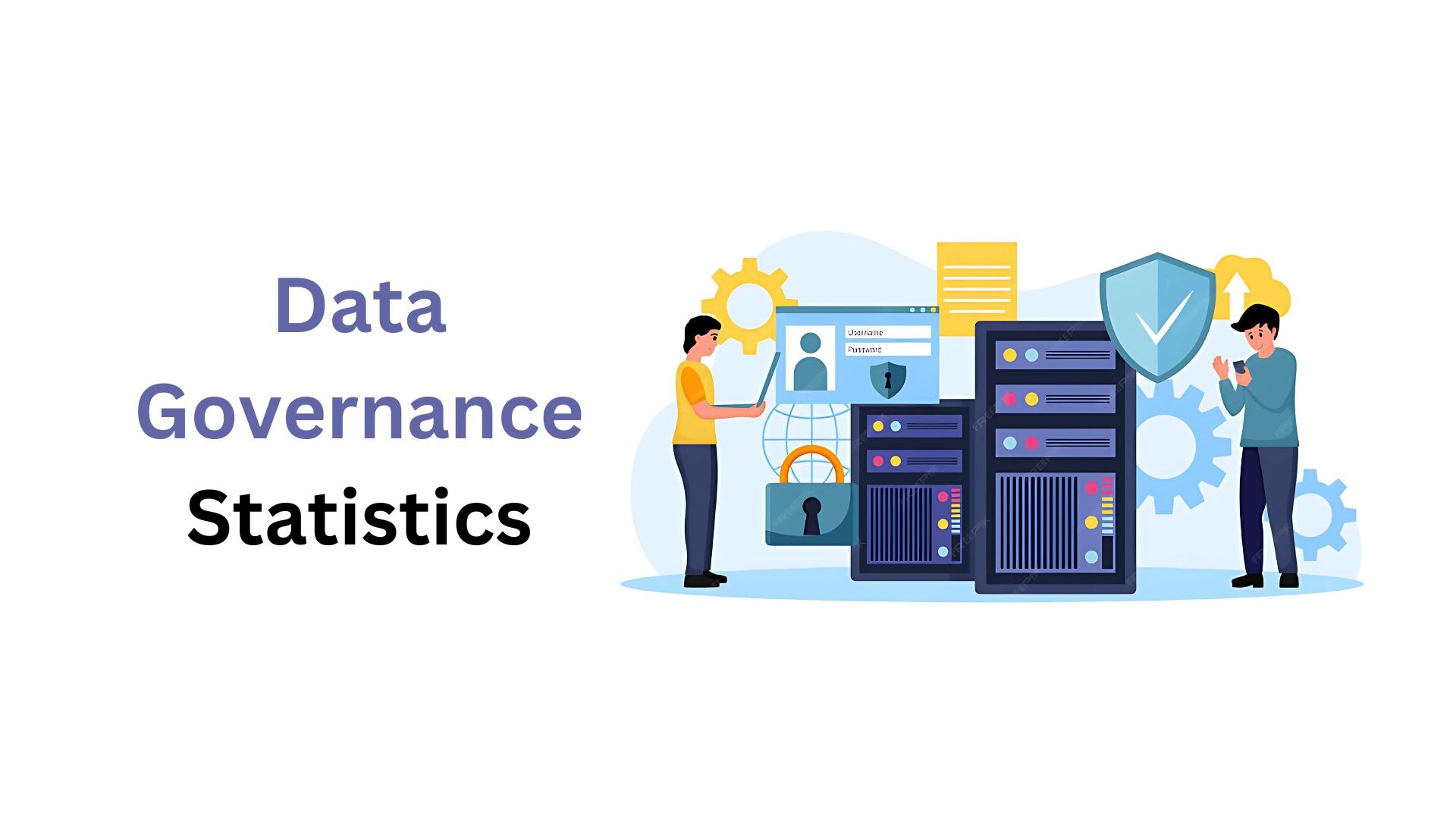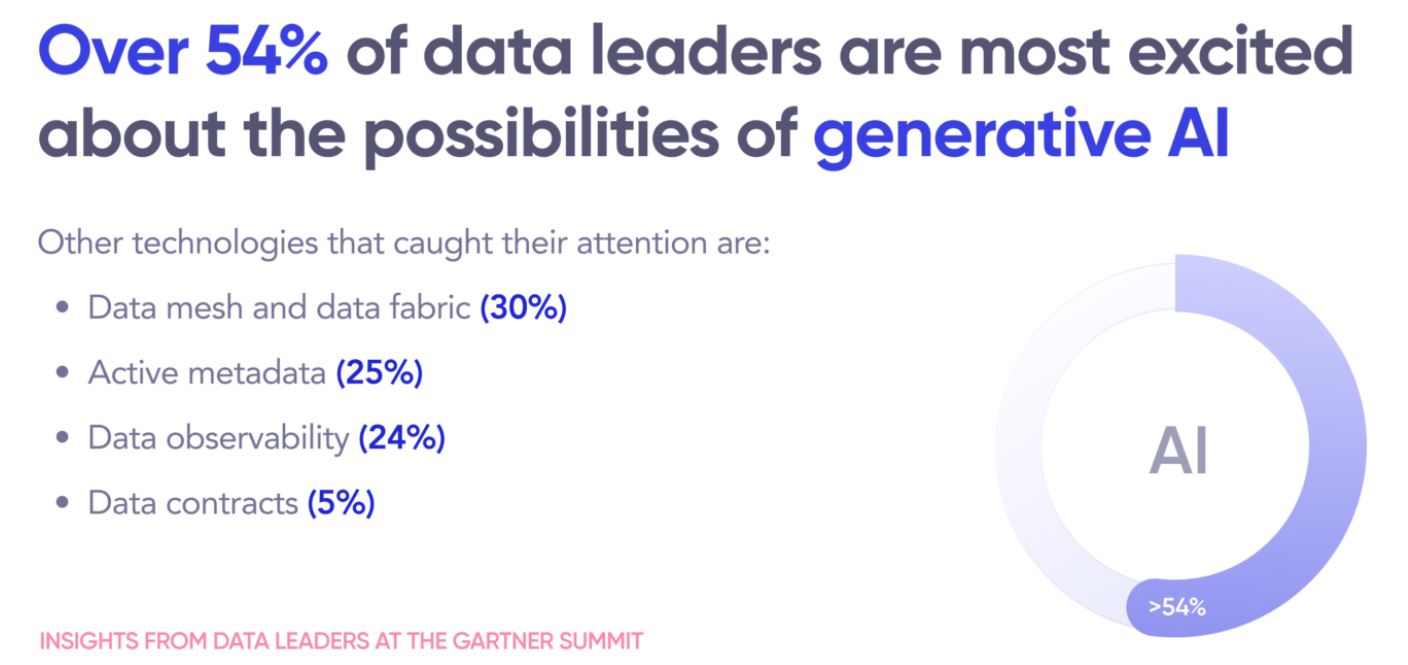Data Governance Statistics And Facts (2025): Emerging Technologies, Challenges And Adoption, AI, ROI, and Data Quality Insights
Updated · Sep 24, 2025

Table of Contents
- Introduction
- Editor’s Choice
- Data Governance Tops The 2024 Data Leadership Agenda
- Why Data Governance is Increasing In Relevance In 2024
- Data Governance Emerging Technologies
- Challenges And Adoption Levels Of Generative AI In Data Governance
- Data And Analytics Budgets And ROI Tracking In 2024
- The High Cost of Poor Data Quality And The Growing Importance of Data Governance
- Conclusion
Introduction
Data Governance Statistics: Data Governance, which needs to ensure that data is accurate, well-managed, secured, and used responsibly, has become even more vital in 2024. As more and more data gets pushed from companies and new laws related to privacy and AI start coming in, governance has now firmly become an absolute business necessity rather than something to have. It was time to observe the key statistical trends, levels of adoption, benefits, challenges, market size, and ever-changing regulatory landscape of data governance in 2024.
Editor’s Choice
- In 2024, more than 65% of data heads declared data governance their priority, surpassing AI (44%) and data quality (47%).
- 62% of organisations stated that data governance was the greatest impediment in the way of AI advancement because of concerns surrounding data lineage, data quality, privacy, and security.
- The increased adoption of data mesh- and data fabric-centric architectures, from 13% in 2023 to 18% in 2024, further buttresses the need for governance structures.
- While 54% of data leaders are excited about generative AI, only 14% have it running in production, with 7% having outright banned its use.
- The investment and strategic importance associated with data continue to grow, with more than 56% of data leaders raising their budgets for data and analytics in 2024.
- Despite increasing investments, only 11% of data leaders consider their D&A efforts to be business consequences, while above 50% do not formally track ROI.
- Poor data costs companies 12% of revenue, while between 60% and 73% of the data is left unused for any strategic purpose.
- 84% of digital transformation projects are marked as failures, for the reasons mostly attributed to poor data quality and governance.
- The data governance market is expected to reach US$5.28 billion by 2026, registering a CAGR of 20.83%, growing from US$1.81 billion in 2020.
- Bruised about their data, 77% of consumers say they would consider stopping any association with a company due to improper data handling or loss.
Data Governance Tops The 2024 Data Leadership Agenda

(Reference: humansofdata.atlan.com)
- In the year 2024, according to more than 65% of data leaders, data governance is ranked as the number one priority, placing it well ahead of other competing concerns such as data quality (47%), artificial intelligence (44%), self-service analytics (32%), and DataOps (19%).
- This shift clearly emphasises that governance is even now considered the bedrock for all other data initiatives.
- Without clearly defined ownership, rules, and oversight, the very best analytics or AI system could yield results that are unreliable or out of compliance.
- For instance, the lower ranking of self-service analytics may highlight persisting challenges in its adoption data silos, inconsistent definitions, or mistrust of the users themselves.
- Exactly, these are the issues strong governance can tackle.
- Effective data governance brings some order into chaos. It fosters:
- Data-driven Trusted Decisions
- Operational Efficiency
- Regulatory Compliance
- Cross-Team Collaboration
- More importantly, Transparency & Trust in Data.
Why Data Governance is Increasing In Relevance In 2024
- In the year 2024, data governance has emerged as the biggest hindrance to AI development, according to 62% of organisations.
- This is due to the great importance given to knowing the data lineage and whether it meets the standards for quality, privacy, and security to be worthy for being considered for training AI models that can be trusted.
- Global regulatory frameworks have kept tightening over the past years, with a special focus on PII.
- Therefore, governance is a number one priority, not only for the sake of innovation, but also to be in compliance with regulation, which is the key goal for 45% of organisations in their governance programs.
- Another huge driver for increased attention to data governance has been the rise of modern data management frameworks.
- Data mesh and data fabric, which saw adoption going up from 13% in 2023 to 18% in 2024, have been seen as frameworks that empower democratised, self-service analytics.
- Corroborating this trend are also the rising data catalogue implementations, with 25% of respondents focusing on them in 2024.
- These catalogue tools aid in helping users find, understand, and trust data for their analytics or AI needs.
- Another driver is data integrity. 56% rate data quality as the biggest integrity challenge, with data governance close behind at 54%, a huge jump from only 27% in 2023.
- This steep rise is telling: if you want to have trusted data, a realization must come upon organisations that data must be governed well-from the moment of collection to end consumption.
- Together, these factors set in motion an unprecedented surge in data-governance efforts.
- Yet, integrating such dissimilar data sources and maintaining governance over these systems is complex, and, as such, one should continue investing and putting strategic focus into making sure that governance programs achieve sustainability and make an impact.
Data Governance Emerging Technologies

(Source: humansofdata.atlan.com)
- 54% of data leaders really look forward to generative AI in 2024, and as enthusiasm grows fast, organisations are undergoing a significant shift toward how they view D&A in the future.
- Organisations no longer perceive generative AI as any mere technical novelty but rather as a big engine capable of empowering business transformation.
- Noteworthy causes for many data leaders could be the hope that it transforms business models, personalizes customer experiences, enhances the customer experience, automates unusually difficult tasks, and opens new avenues for innovation.
- This excitement is part of a broader trend in the data governance space where companies look for new technologies and frameworks to keep pace with the increasing complexity and volume of data.
- For example, 30% of data leaders are eyeing modern data environments that decentralise data ownership and create scalable self-service data environment architectural frameworks, such as data mesh and data fabric.
- Such models enable organisations to govern exceedingly large, distributed data ecosystems more efficiently, permitting teams the liberty to access, manage, and analyze data independently with respect to global standards.
- Another 25% of leaders cited being interested in active metadata, meaning real-time records of how data got used or where it passed through (lineage), or about data quality, so the overall visibility and trust can be enhanced in the data pipeline.
- Meanwhile, data observability, being paralleled with looking into and diagnosing data issues, gathered the attention of 24% of respondents, showing the increasing need for proactive health checks and transparency of data.
- Data contracts, on the other hand, stand for agreements between data producers and consumers that set out expectations and responsibilities, but were of far less interest to respondents (5%) in data leadership.
- This is arguably because, while good in theory, implementable data contracts may still be at a nascent stage of adoption or perceived to be too technical or complex for immediate value.
Challenges And Adoption Levels Of Generative AI In Data Governance
- Generative AI continues to be the subject of hype and enthusiasm among data leaders; however, in 2024, a major challenge is that very few have operationalised generative AI within their working environments.
- A recent survey yielded that 47% of data leaders are still in the research phase, looking for the “right” technology and potential use cases for generative AI.
- This clearly implies great attention, but many organisations still do not know how to leverage the technology in a business-oriented manner.
- One reason for this contradictory position stems from a lack of clarity on how generative AI can impact businesses.
- Numerous leaders want more examples or case studies to show that the investment and effort required for implementation are justified.
- Without these proven mechanisms for benefit, one finds it difficult to bring up a solid business case for generative AI.
- Only 30% of organisations have proceeded with PoC projects to explore generative AI potential and showcase it on a limited scale.
- These projects are useful for learning, as well as internal validation, but they are by no means full-scale deployments.
- Even fewer, a mere 14%, report that some type of generative AI was put to use in production-level use cases, wherein the technology is actively driving business processes or customer-facing applications.
- The very low number suggests that many technical, strategic, and compliance issues are still perceived as obstacles to a wider deployment.
- The other interesting fact is that 7% of the organisations have gone so far as to outright ban the use of generative AI.
- These bans could stem from concerns related to data privacy, misinformation, regulatory compliance, or just from a sheer lack of preparedness to responsibly manage the new technology.
Data And Analytics Budgets And ROI Tracking In 2024
- In 2024, data and analytics (D&A) continue to grow in importance in organisational strategy, as 56% of data leaders report increased D&A budgets.
- This increase in investment points to a strong commitment to leveraging data toward better decision-making, innovation, and a competitive edge.
- The raising of funding levels also points to a recognition of D&A as a strategic asset, and not just a support function.
- On the downside, however, only 8% of the data leaders revealed that their budgets were downsized, whereas 35% stated budgets remained unchanged, supporting once again the trend of most organisations making, at the very least, an equal investment in data initiatives.
- In spite of increasing budgets, a glaring disparity is still evident in how data teams measure and express their value.
- Over half of the data leaders, the survey noted, do not have any formal means of measuring the ROI of their data efforts. This implies that even though investments are going up, many organisations are still trying to figure out how to articulate the impact of their D&A teams on larger business objectives.
- Currently, operational KPIs such as request fulfilment rates, developer hours, or time taken to resolve data-related tickets are tracked by about 27% of the data leaders.
- These internal performance metrics lack showing how data initiatives help business outcomes in terms of revenue growth, cost savings, or customer satisfaction levels.
- Only 11% of data leaders have set both quantitative and qualitative success metrics that can be linked directly to business objectives.
- With budgets growing, data leaders are now facing increasing pressure to prove the ROI of their efforts.
- Therefore, strengthening the link between data work and business impact further shall justify more investment, while also aiding in positioning the data teams as critical forces of growth and innovation.
The High Cost of Poor Data Quality And The Growing Importance of Data Governance
- McKinsey claims that the average employee spends 2 hours per day searching just for relevant information, killing productivity due to unstructured and disorganised forms of data.
- Experian Data Quality cites that an average bad data bill weighs about 12% of a company’s annual revenue, while Forrester mentions a rate of 60 to 73% of enterprise data never used strategically.
- Even worse is that behind the four inefficiencies, Forbes states that 84% of digital transformation endeavours fail.
- 77% of consumers said that they would stop doing business with companies misusing or losing their data, and 32% had opted out of personalised advertising in the last year.
- The data governance market was valued at US$1.81 billion in 2020 and is expected to garner US$5.28 billion by 2026 at a CAGR of 20.83%. This is indicative of the growing awareness of the need for data oversight.
- Poor data quality is quite the prevailing issue, with 65 % of contact details collected through online forms being wrong.
- 54% of companies cited data quality and completeness as issues.
- 57 % of marketing teams have had their work impacted negatively by the wrong interpretations of data, which shows that poor data quality has a direct impact on performance.
- Another sign of the booming data economy comes from China, where the data volume is expected to jump from 7.8 zettabytes in 2018 to 48.6 zettabytes in 2025, accounting for 27.8% of global data creation, as stated by IDC.
- In 2019, net spending for systems dealing with building first-party data went up by 9.8% to US$5.5 billion, whereas third-party data spending grew 6.1% to US$11.9 billion, according to IAB.
- The TDWI estimate places the cost of data maintenance-related problems to the firm at over US$600 billion a year, while IBM figures that America alone loses US$3.1 trillion each year due to data quality issues.
- Aside from having external mishaps, firms confront very cumbersome internal data systems.
- A Deloitte survey found that the average company uses 17 different technology applications to store customer data and that 70% of executives’ time is spent finding data as opposed to analysing it.
- Harvard Business Review states that 47% of newly collected data is seriously flawed.
- The Global Data Transformation Survey divulged that 30% of the enterprise time is wasted doing low-value work because of poor data access and quality.
- Another interesting statistic is that data management will grow 40% competitively over the next two years, and the cost of outsourcing such services may fall by 48%.
- These changes point to a surge in demand for the operations of internal data systems and governance frameworks.
Conclusion
In 2024, governance of the data set became a cornerstone enabler in strategic planning across industries. Data-governance programs bring forth tangible benefit areas into analytics, data quality, collaboration, and compliance-under which more than 50% of organisations have witnessed some returns.
New regulations, futuristic architectures such as data mesh/fabric, and the coming of generative AI have all been put into consideration to further accelerate the transformation of governance from a mere back-office activity to a centre-stage strategic enabler.
FAQ.
It is said in the coming of age data governance period that over 65% of data leaders in 2024 prioritised data governance issues over AI and Data Quality. The surge has been due to the necessity of trusted, secure, and compliant data in a world that deals with AI, regulatory pressure, and decentralised architectures such as Data Mesh and Data Fabric. In strong governance-dependent terms, data integrity, efficient operations, and transparency are ensured.
In fact, 62% of organisations cite data governance as the biggest barrier to AI adoption. Without trusted data lineage, quality, or privacy safeguards, AI models end up being unreliable or non-compliant. Governance is no longer a service to innovation but an obligation under modern regulations.
While 54% of data leaders are excited about generative AI, only 14% have deployed it in production. Around 47% are still researching, 30% are in testing through PoC projects, and 7% have outright prohibited it. These barriers include uncertainty around use cases, compliance, and measurable outcomes.
Despite 56% of data leaders pumping up D&A budgets, more than half of them do not practice formal tracking of the ROI. Just 11% of them tie data initiatives to business outcomes. Internal metrics are mostly what organisations track now, but they cannot show strategic impact, thus creating an investment versus measurable value gap.
Bad data quality is a revenue killer-two companies can pluck up to 12% of revenue-while between 60 and 73% of data remains unused. Bad data contributes to inefficiency, failed digital transformation efforts, and erosion of consumer trust. Also, 77% of their customers would stop doing business with an organisation that misuses their data, thus spotlighting the risks of poor data governance.

Tajammul Pangarkar is the co-founder of a PR firm and the Chief Technology Officer at Prudour Research Firm. With a Bachelor of Engineering in Information Technology from Shivaji University, Tajammul brings over ten years of expertise in digital marketing to his roles. He excels at gathering and analyzing data, producing detailed statistics on various trending topics that help shape industry perspectives. Tajammul's deep-seated experience in mobile technology and industry research often shines through in his insightful analyses. He is keen on decoding tech trends, examining mobile applications, and enhancing general tech awareness. His writings frequently appear in numerous industry-specific magazines and forums, where he shares his knowledge and insights. When he's not immersed in technology, Tajammul enjoys playing table tennis. This hobby provides him with a refreshing break and allows him to engage in something he loves outside of his professional life. Whether he's analyzing data or serving a fast ball, Tajammul demonstrates dedication and passion in every endeavor.










